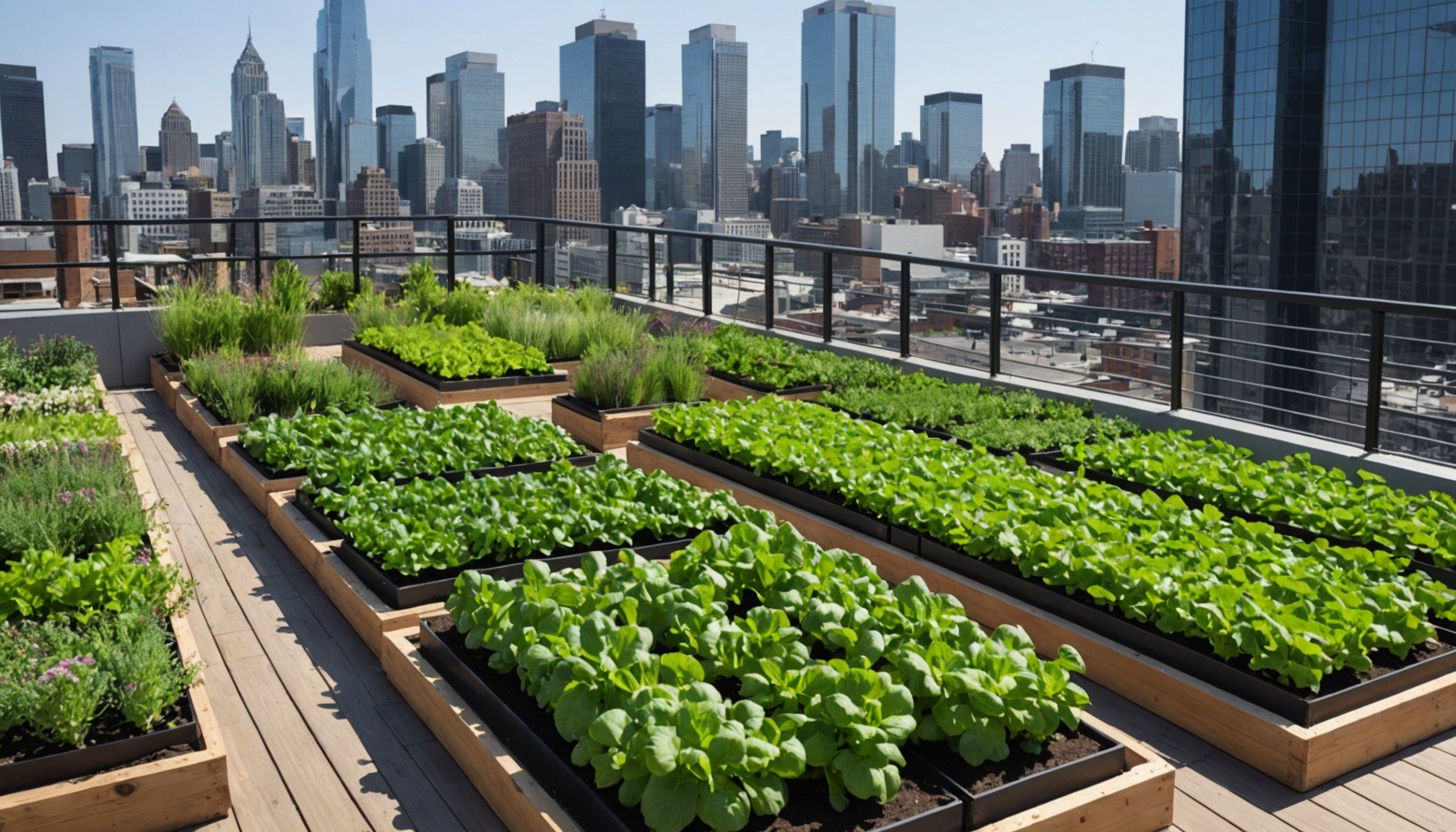Overview of Rooftop Gardens for Restaurants
Rooftop gardens are rapidly gaining popularity in the restaurant industry as a result of the rising demand for locally-sourced ingredients. These green spaces not only enhance sustainability through urban innovation but also allow restaurants to cater to environmentally conscious diners. By tapping into sustainable agriculture practices, rooftop gardens contribute significantly to the urban landscape.
Urban settings benefit enormously from rooftop gardens since they provide a unique solution to the challenges of space constraints. They improve air quality, reduce urban heat, and manage stormwater runoff, highlighting their environmental benefits. Moreover, they are valuable assets in promoting biodiversity within cities by providing habitats for pollinators and other wildlife.
Topic to read : Master Pest Control Techniques to Ensure Your Rural Gastropub Thrives
Statistics reveal a notable growth: many restaurants are incorporating rooftop gardens as part of their gastronomic experience. Establishments have reported an increase in both customer interest and menu diversity, as these gardens allow chefs to experiment with fresh, home-grown ingredients that are vibrant and flavourful. For diners, the appeal lies in having a farm-to-table experience that is both authentic and engaging. Consequently, rooftop gardens serve as a powerful marketing tool by aligning modern dining experiences with environmental sustainability.
Design Concepts for Rooftop Gardens
Rooftop gardens are an extension of sustainable architecture, combining nature with urban spaces. When examining rooftop garden design, thoughtful urban landscaping plays a crucial role in creating aesthetically pleasing and functional spaces.
In the same genre : Menu mastery: key ingredients for creating a captivating restaurant menu
Space Utilization Techniques
Urban areas often wrestle with limited space. Clever design ensures that these small spaces are maximized. Utilizing tiered layers or partitioned zones allows for a variety of plants while maintaining consistent sunlight and accessibility.
Vertical Gardening Solutions
Vertical gardening is a fantastic solution for rooftops. With creative setups, green walls host multiple plant species, capturing sunlight efficiently. This technique is excellent for growing herbs and smaller vegetables and can transform bare walls into lush, green canvases.
Container Gardening Strategies
Container gardening offers flexibility in plant selection and arrangement. Containers of varied sizes enable strategic planting, facilitating the arrangement of both decorative and edible plants. They also make maintenance straightforward, as individual containers are easily accessed for watering and care.
Innovative systems in rooftop garden design not only enhance aesthetics but also bolster urban landscaping by turning rooftops into eco-friendly havens, effectively pulling nature into city life.
Selecting Plants for Sustainable Ingredients
Rooftop gardens serve as a vibrant platform for cultivating sustainable plant choices that cater to the restaurant industry’s demand for fresh, locally-sourced ingredients. When selecting plants for urban gardening, it is essential to choose those that thrive in such environments. Edible plants like herbs, vegetables, and fruits are ideal for rooftop settings. Herbs such as basil, mint, and rosemary are particularly suited to these environments due to their adaptability and the flavour enhancement they provide to dishes.
Emphasising seasonal planting enhances sustainability and ensures a continuous yield that aligns with natural growth cycles. In urban rooftops, selecting crops based on seasonal variations is crucial for healthy plant development and maximising harvests. Additionally, native and low-maintenance plants can contribute significantly to environmental conservation. These selections require less water and maintenance, thereby supporting sustainable practices.
Choosing plants wisely not only elevates menu offerings but also fosters a connection between diners and nature. The integration of sustainable ingredients in restaurants enhances the dining experience by allowing patrons to enjoy dishes that reflect seasonal freshness and ecological mindfulness. This strategic plant selection showcases a commitment to both gastronomy and environmental preservation.
Maintenance Best Practices
A well-maintained rooftop garden ensures sustainability and maximises the benefits of urban gardening. Effective rooftop garden maintenance is essential for longevity and health of plants.
Watering and Irrigation Systems
Efficient watering systems are pivotal. Utilizing drip irrigation reduces water waste, delivering moisture directly to the plant base. This method conserves water and maintains consistent soil hydration, promoting plant health during dry spells.
Pest Management Techniques
Pest control in urban settings can be challenging. Opt for organic pest management, using natural predators like ladybugs or neem oil to address infestations. This approach supports sustainable practices by minimizing synthetic chemical use, preserving the garden’s ecosystem.
Seasonal Care Routines
Adapting to seasonal changes is crucial. Routine tasks include pruning dead foliage in autumn and mulching during winter to protect roots. Each season presents unique challenges; stay proactive to ensure resilience. Regular checks for disease and adjusting care strategies as seasons change enhance garden productivity year-round.
These practices not only bolster plant preservation but also embody sustainable urban gardening tips, ensuring gardens thrive as environmentally friendly and resource-efficient havens.
Case Studies of Successful Rooftop Gardens
Rooftop garden case studies provide insight into how these innovative spaces transform restaurants’ approach to sustainability and customer experience. Several establishments demonstrate remarkable success by integrating restaurant sustainability and utilizing rooftop gardens, leading to both financial and environmental benefits.
One notable example is a renowned city bistro that incorporated a rooftop garden, resulting in fresher menu offerings. This initiative allowed for an increase in diverse ingredients, leading to heightened customer engagement. Another restaurant capitalized on successful implementations by partnering with local farmers for garden management, creating a seamless farm-to-table experience.
These gardens notably affect menu offerings, as chefs have the opportunity to experiment with seasonal ingredients. Such creativity not only pleases the palate but also attracts a clientele eager to explore sustainable dining options. Furthermore, the implementation of rooftop gardens has been shown to significantly cut costs associated with purchasing produce, while also reducing the carbon footprint.
The shift towards restaurant sustainability through rooftop gardening enhances the dining experience and establishes a deeper connection with environmentally conscious diners, showcasing the financial and environmental benefits of these green investments.
Funding and Community Engagement Resources
Access to rooftop garden funding is critical for executing successful urban agriculture projects. Various urban agriculture grants are available to support these initiatives, often provided by government programs and non-profit organizations. Such funding can alleviate financial constraints, allowing restaurants to invest in necessary infrastructures, like soil and irrigation systems, facilitating the transformation of rooftops into productive gardens.
Establishing community partnerships is another impactful way for restaurants to implement and sustain rooftop gardens. Collaborating with local groups, including horticultural societies and environmental organizations, can provide not only additional resources but also valuable expertise. These partnerships can drive community initiatives, creating a network of support around the garden projects.
Involving patrons directly in these endeavours is yet another strategy. By hosting seasonal events or educational workshops focused on urban agriculture, restaurants can engage their clientele, fostering a sense of ownership and support for the gardens. Integrating these activities with the dining experience enhances customer loyalty and investment in the restaurant’s sustainability efforts, showcasing their commitment to eco-friendly practices and encouraging patrons to be active participants in supporting rooftop gardens.








